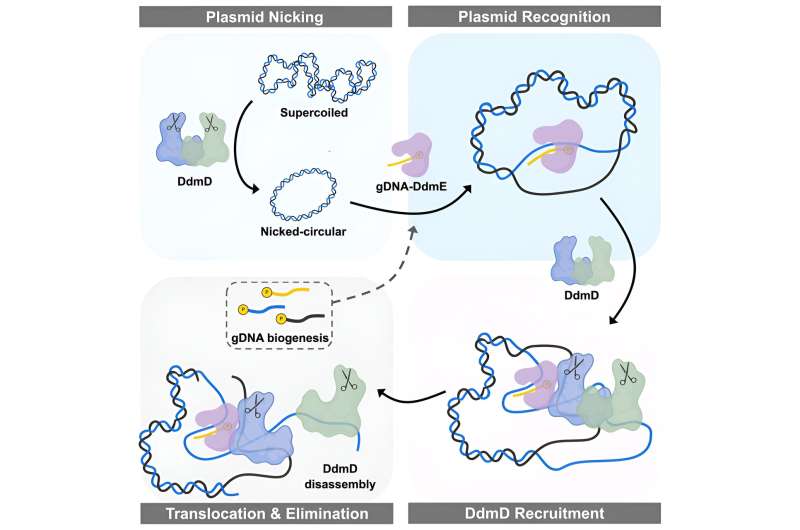This article has been reviewed according to Science X's editorial process and policies. Editors have highlighted the following attributes while ensuring the content's credibility:
fact-checked
peer-reviewed publication
trusted source
proofread
Bacterial defense strategy has potential application in genome editing

Scientists who have described in a new study the step-by-step details of a bacterial defense strategy see the mechanism as a promising platform for development of a new genome-editing method.
The system involves two proteins that team up to disable plasmids, small DNA molecules that exchange genetic information among different bacterial strains. While plasmids provide evolutionary benefits, they can also be seen by host bacteria as threats.
The research team determined that one protein uses a short piece of DNA—known as a DNA guide—to set off events that recruit another protein to chop up the plasmid.
Beyond revealing a secret to bacterial survival, the research has uncovered components that could be applied to gene editing: guide DNA, which is more stable and cheaper to synthesize than guide RNA, and a functional protein small enough to deliver into mammalian cells for DNA sensing and gene-editing purposes.
"This system has great potential to be developed into a genome-editing tool," said Tianmin Fu, assistant professor of biological chemistry and pharmacology in The Ohio State University College of Medicine. "We're now trying to test whether it can be reprogrammed into a useful technology."
The paper was published on Aug. 21 in the journal Cell.
The presence of plasmids in bacteria is well-known—some bacteria secrete plasmids, and the molecules can also move from one cell to another to share genetic information.
"It's why bacteria evolve so rapidly," Fu said. "Sometimes, plasmids can integrate into genomic DNA, but this happens quite randomly. They might cause difficulty for individual bacterial survival, but plasmids benefit the community in the long run because genetic information allows bacteria to acquire new features."
Still, bacteria tend to want to eliminate plasmids to prevent any random threatening actions they might take.
Fu and colleagues used Vibrio cholerae bacteria as a model for studying the plasmid defense system known as DdmDE, consisting of proteins called DdmD and DdmE, using cryo-electron microscopy to observe their functions.
The process begins with DdmE binding to a very short DNA fragment, known as guide DNA, which enables the protein to recognize a target plasmid and snag it by creating a bubble formation using one of the plasmid's double strands. The bubble complex recruits the DdmD protein, which can bind only to the plasmid's free remaining strand. Once bound, DdmD dissociates into two separate molecules that both function as clippers to cut the plasmid into pieces.
Preliminary data from the team's experiments suggested that a plasmid fragment remaining after DdmD chops it up could function as a segment of guide DNA to which DdmE could bind to repeat the process.
"There appears to be a feedback loop," Fu said. "Once you create plasmid fragments, then more DdmE can acquire the fragments as guides to target more plasmids in the cell."
However, he added, "How the first guide was created in the cell is unclear to us at the moment. It's a 'chicken and egg' situation."
The finding was unexpected because DdmE has similar qualities to a superfamily of Argonaute proteins that trigger their host bacteria's death to avoid plasmid invasion. Argonautes, however, are aided by guide RNA, not guide DNA—and the guide DNA is a major reason the DdmDE system is attractive as a platform for genome editing aimed at disease prevention.
"Because DdmE needs guide DNA, we can synthesize guide DNA to target a very specific area in a genome," Fu said. "We are testing this now in mammalian cells to see whether it will work, and we do see some potential there."
More information: Xiao-Yuan Yang et al, DdmDE eliminates plasmid invasion by DNA-guided DNA targeting, Cell (2024). DOI: 10.1016/j.cell.2024.07.028
Journal information: Cell
Provided by The Ohio State University




















